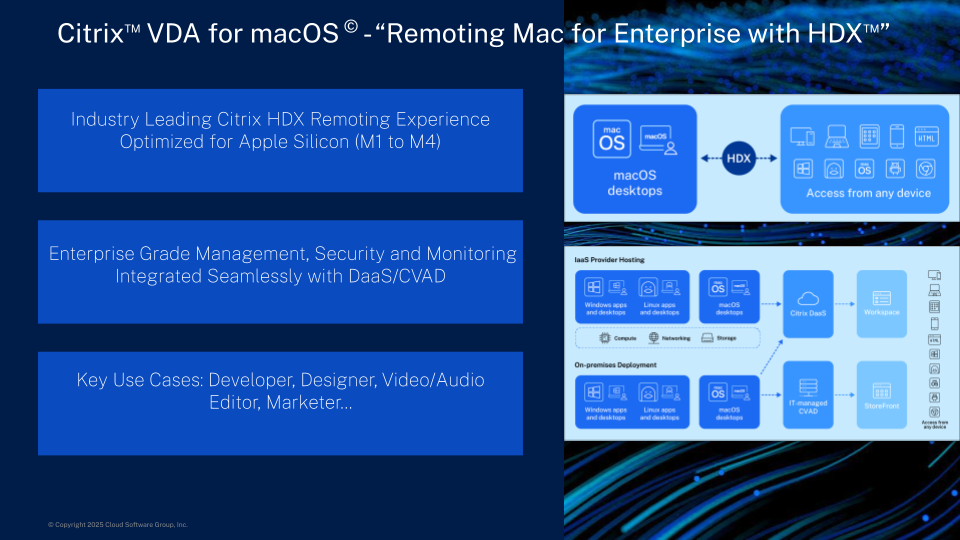This blog was co-authored by Todd Terbeek, Managing Director, Strategic Alliances, at Citrix.
Citrix VDA for macOS (macOS VDA) is Citrix’s premier solution for enterprise macOS desktop remote access. From the outset, it was designed specifically for Apple silicon, capitalizing on the platform’s superior performance and power efficiency. Apple silicon’s ingenious SoC design, integrating the CPU, GPU, Neural Engine, Secure Enclave, media and display engines—all paired with fast unified memory—optimizes macOS VDA for minimal system footprint and maximizes compute/AI resources for user apps. This results in a native macOS desktop experience under optimal network conditions. The latest M4 chip further enhances macOS VDA performance substantially in our latest 2411 release.
Apple’s transition to Apple silicon for Mac in 2020 marked a strategic shift from Intel processors to its own architecture. The latest Macs featuring the M4 family of chips represent a generation leap in performance and are well-positioned to meet the enhanced efficiency, security, and productivity needs of businesses. Apple’s M4 chip, built on a 3-nanometer process with 10-core CPU, 10-core GPU, and a 16-core Neural Engine provides an ideal foundation for desktop remote access technologies like HDX, the underlying remote desktop protocol and feature sets implemented by macOS VDA.
For security, flexibility, and IT management reasons, enterprises have a need for remote access to macOS, for example to support developer and designer use cases. This requires a secure and enterprise-grade management platform from Citrix. Citrix HDX user experience technology, with over three decades of experience in this domain, powered by Apple silicon, is the ideal solution.
macOS VDA, leveraging Apple silicon’s powerful CPU, GPU, and Media Engine, optimizing for unified memory significantly accelerates performance and reduces the system footprint by preventing data copies between the CPU and GPU. Our initial iteration demonstrated average single-digit CPU utilization for typical HDX workloads and less than 1% GPU utilization. It also delivered approximately 30 to 60 FPS for diverse enterprise workloads.
These impressive results have contributed to the rapid adoption of macOS VDA from our customers. Today, we have over 100+ global customers from various verticals, including finance, medical, ICT (Information & Communications Technology), and education, actively using macOS VDA since our last September GA.
In the latest macOS VDA 2411 release, our benchmark on Mac mini with M4 shows an astonishing 17% increase in HDX remote access experience when using pure CPU-based encoding algorithms (Citrix HDX Thinwire technology) and a 15% increase when using hardware H.264 encoding compared to the previous generation hardware. These improvements further enhance the end-user experience of remote macOS desktops.
Additionally, when Citrix developer teams transitioned to the latest Macs powered by Apple silicon for daily work, they experienced a remarkable five-fold improvement in application build pipeline performance (both new and incremental builds) compared to x86 Intel-based Macs.
In summary, the latest Mac lineup with M4 provides a significant performance boost for enterprise applications like Citrix VDA for macOS, enhancing the end-user experience. Apple silicon offers enhanced security, performance, and power efficiency, positioning it at the forefront of compute and AI trends. We are committed to building the macOS desktop remote access market’s growth with strong support and collaboration from the Apple ecosystem. We look forward to a successful 2025 ahead!




